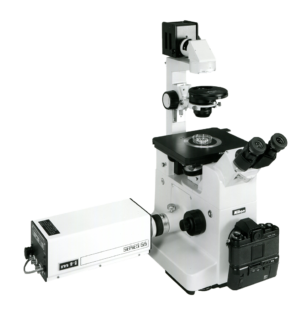Nikon’s Museum of Microscopy
Diaphot 200/300 Inverted Microscope
( 1994 )

Introduced in 1994, this was an extension of the world renown Diaphot series that was originally introduced in 1985 and had become the most the most widely used inverted microscope of the period.
As technology in the microscope field advanced, this updated product incorporated some of the latest technologies for applications ranging from basic microscopy, fluorescence and the fledging Confocal technology.
The most demanding techniques in optical microscopy required increasingly high efficiency in light transmission, utilizing every photon available to produce an image. Applications involving lasers, sprectrophotometers and digital detectors as well as low light techniques in fluorescence and video enhanced imaging were at the cutting edge of technology at the time and required microscope equipment to not only be efficient in light transmission, but also provide additional ports for detectors of various types. Nikon had successfully improved transmission efficiency with better optical technology and simplified light paths.
The Diaphot boasted a side image port which utilized a prism to allow easy switch over from eyepiece and even allowed a 80%/20% split between the side port and the binocular eyepiece. Additionally there was a bottom direct port that provided for 100% transmission to the detector.
The scope also boasted full capability for epi fluorescence and Nomarski DIC and a significant improvement in ergonomic design.
This scope continued its reign until it was replaced with the TE200/300 in 1996. The most current successor of the Diaphot 200/300 is the Nikon Eclipse Ti2 inverted microscope.













